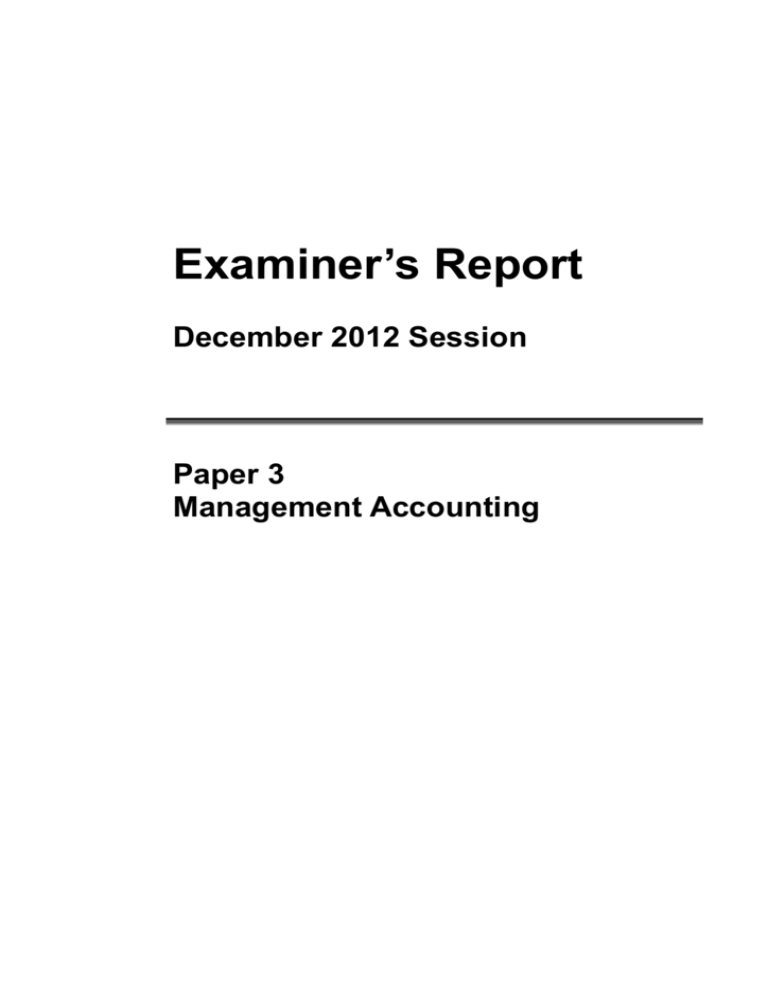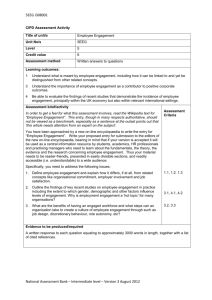Examiner's Report
advertisement

Examiner’s Report December 2012 Session Paper 3 Management Accounting General Comments Candidates performed quite well in this paper. The passing rate for this session was higher than that in previous sessions. The compulsory Section A and optional Question C2 were most satisfactorily answered while Question C3 was badly answered. Most of the candidates were able to master the basic concepts of management accounting and apply them to solve the practical problems. As usual, candidates were weak in answering theoretical questions when compared to numerical ones. Section A – 15 Multiple-choice Questions The overall performance of the candidates was good. This reveals that candidates were willing to pay more attention to this section and had prepared themselves properly for the examination. Section B – 1 Compulsory Question Question B1 This compulsory question aimed to examine candidates’ knowledge on budgeting, pre-determined overhead absorption rate (POAR) and computation of production cost. The overall performance of this question was good and more than half of the candidates got a pass. Part (a) required candidates to prepare the production budget (in units) for each of the two products. A majority of them was able to compute the answers correctly and got full marks in this part. Candidates were asked to prepare the direct material purchase budget and the direct labour budget in parts (b) and (c) respectively. Some candidates provided wrong answers for the direct material purchase budget as they failed to recognise that the closing inventory should be added while opening inventory should be deducted in the computation. Most candidates were able to handle the direct labour budget properly. For part (d), except those candidates who did not know how to compute the budgeted direct labour hours for the coming year, a majority of them were able to compute the POAR correctly. Part (e) required candidates to show all cost elements for the products and compute their respective unit production costs. This part was not performed well. Some candidates mistakenly used the purchase cost figures calculated in part (b) for each type of material as the material cost for each product. Therefore, candidates should be cautious in their computations. Few candidates got high marks for part (f) because they failed to explain clearly the difference between a fixed budget and a flexible budget. Section C – 3 Optional Questions Question C1 This was the second least popular question and the performance was good. Part (a) of this question was designed to examine candidates’ ability to prepare the process account using the weighted average method. The poor performance of some candidates might be due to the fact that they did not know how to compute the units completed from the data given (i.e. material input + opening work in process – closing work in process – normal loss + abnormal gain). In addition, few of them did not read the question carefully. They prepared only the process account and did not show detailed workings on equivalent units and cost per equivalent unit of individual cost elements as required by the question. Therefore, candidates should be more cautious in reading the question in order not to lose marks. Part (b) was answered satisfactorily as most candidates were able to explain the meaning of abnormal gain. Question C2 This was the most popular question in this section and was generally well answered. This question aimed at testing candidates’ ability in calculating production overhead absorption rate based on traditional and activity-based costing approaches. Candidates were required to calculate the production cost per box for each product if all production overheads were absorbed on a machine hour basis in part (a). The majority of them were able to compute the answers correctly. Some candidates could not obtain full mark for this part since they stated the total production overhead absorbed by each product directly as the answer and failed to provide the machine hour overhead absorption rate computed. Part (b) asked candidates to calculate the production cost per box for each product using activity-based costing. Most candidates were able to arrive at the correct answer for this part. However, same as part (a), some candidates did not show the cost driver rate for each activity or workings on the overhead absorbed as required. Therefore, candidates should note that all workings should be shown in their calculation so as to score full marks. In addition, some candidates gave the correct formulae, but wrote down incorrect answers in the answer books. This reveals that candidates were careless in using their calculators or copying the figures onto the answer book. Part (c) was an essay-type question which required candidates to explain why activity-based costing is more preferable than traditional absorption costing and comment on the result computed in parts (a) and (b). This part was not performed well and most of the answers were irrelevant. Candidates were not able to express their opinions correctly. Question C3 This was the least popular question and was handled badly. This question consisted of two parts. Some candidates only answered part (b) and omitted part (a). In part (a), candidates were asked to calculate (i) the economic order quantity (EOQ) using the relevant formula and (ii) the related total relevant cost of different re-order alternatives and give proper advice to management on the best order quantity per order. It appeared that candidates were not familiar with this topic. They did not know the formula for calculating the EOQ as well as the tabular method in presenting the different cost elements for each alternative. It might be due to the fact that this topic had not been examined for a number of sessions and were given little attention by the candidates. Therefore, candidates are advised not to “screening out” topics in their examination preparation. Part (b) required candidates to (i) calculate the contribution margin ratio, the expected profit and the break-even volume of the product for the next year; (ii) explain margin of safety (MOS) and calculate the MOS in dollar value; and (iii) calculate the units to be sold to obtain a target profit. A majority of candidates had no problem in doing part (i). However, few of them got good marks in parts (ii) and (iii) since most candidates failed to explain the meaning of MOS and did not know how to compute the required unit for target profit with relevant formula. As mentioned in previous sessions, CVP analysis is an important concept in management accounting and therefore candidates should study this topic in more details. [ END OF EXAMINER’S REPORT ]








